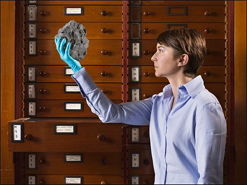Dr Caroline Smith
Chance and a fascination for discovery brought our meteorite curator to the Museum, where she looks after our oldest specimens and acquires new ones.

Early aspirations
Dr Smith became a meteorite expert almost by accident. During the second-last year of her geology degree, she badly injured her knee, meaning she was unable to go on fieldwork for her thesis. Instead, she came to the Museum and was handed a box of meteorites from Antarctica and asked to categorise them.
Ever since, she’s been attached to both meteorites and the Museum, looking after our important collection, planning exhibitions and talking to the public. She says some of the most thrilling days are when big news breaks and she’s asked to talk to the press, such as in February 2013 when a huge meteorite streaked across the sky in Russia.
It's also exciting for her to study meteorites in the Museum labs and 'to know you are the first person to ever look closely at that sample.'
Super specimens
Dr Smith says her favourite specimen is whichever one she’s working on at the time. However, she also says we are fortunate to have some famous meteorites in our collection that are studied by researchers all over the world. One is the Wold Cottage meteorite that fell in Yorkshire in 1795 and helped to prove that meteorites came from space.
The collection also includes two Martian meteorites that fell almost exactly 100 years apart called Nakhla and Tissint, falling in 1911 and 2011 respectively. Nakhla contains evidence Mars was once a wet place, and that some rocks could lock away carbon dioxide, as they do on Earth.
‘It’s another piece of the puzzle that shows that Mars and Earth are actually quite similar,’ she says.
Bringing the past to life
To find out more about what the solar system and planets were like in the past, Dr Smith uses new techniques to study meteorites, such as CT scanning, and helps design space missions to collect material from asteroids and from Mars and its moons.
She also goes on collecting missions to a desert in Australia, where dark meteorites are easy to spot in the pale barren landscape.